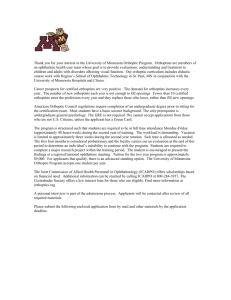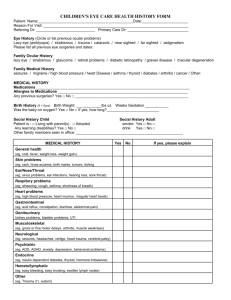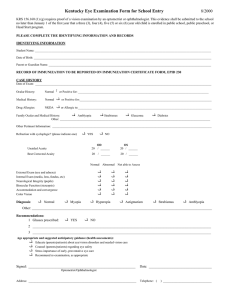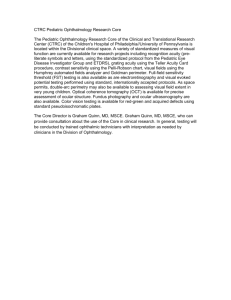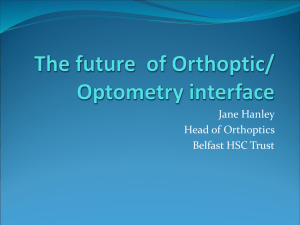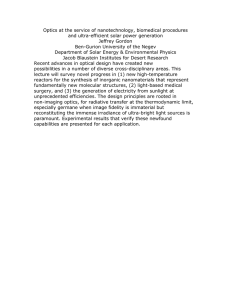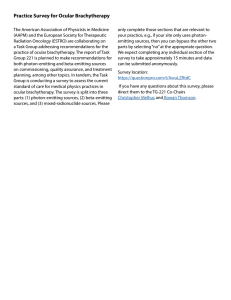Programme Specification
advertisement
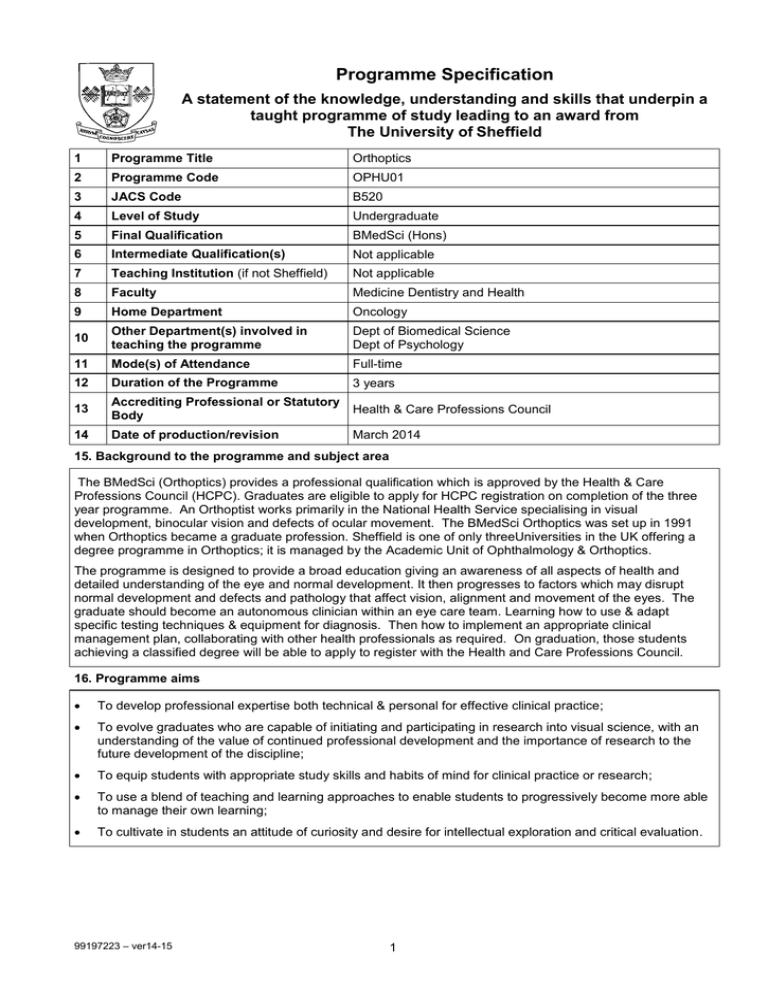
Programme Specification A statement of the knowledge, understanding and skills that underpin a taught programme of study leading to an award from The University of Sheffield 1 Programme Title Orthoptics 2 Programme Code OPHU01 3 JACS Code B520 4 Level of Study Undergraduate 5 Final Qualification BMedSci (Hons) 6 Intermediate Qualification(s) Not applicable 7 Teaching Institution (if not Sheffield) Not applicable 8 Faculty Medicine Dentistry and Health 9 Home Department Oncology 10 Other Department(s) involved in teaching the programme Dept of Biomedical Science Dept of Psychology 11 Mode(s) of Attendance Full-time 12 Duration of the Programme 3 years 13 Accrediting Professional or Statutory Body Health & Care Professions Council 14 Date of production/revision March 2014 15. Background to the programme and subject area The BMedSci (Orthoptics) provides a professional qualification which is approved by the Health & Care Professions Council (HCPC). Graduates are eligible to apply for HCPC registration on completion of the three year programme. An Orthoptist works primarily in the National Health Service specialising in visual development, binocular vision and defects of ocular movement. The BMedSci Orthoptics was set up in 1991 when Orthoptics became a graduate profession. Sheffield is one of only threeUniversities in the UK offering a degree programme in Orthoptics; it is managed by the Academic Unit of Ophthalmology & Orthoptics. The programme is designed to provide a broad education giving an awareness of all aspects of health and detailed understanding of the eye and normal development. It then progresses to factors which may disrupt normal development and defects and pathology that affect vision, alignment and movement of the eyes. The graduate should become an autonomous clinician within an eye care team. Learning how to use & adapt specific testing techniques & equipment for diagnosis. Then how to implement an appropriate clinical management plan, collaborating with other health professionals as required. On graduation, those students achieving a classified degree will be able to apply to register with the Health and Care Professions Council. 16. Programme aims To develop professional expertise both technical & personal for effective clinical practice; To evolve graduates who are capable of initiating and participating in research into visual science, with an understanding of the value of continued professional development and the importance of research to the future development of the discipline; To equip students with appropriate study skills and habits of mind for clinical practice or research; To use a blend of teaching and learning approaches to enable students to progressively become more able to manage their own learning; To cultivate in students an attitude of curiosity and desire for intellectual exploration and critical evaluation. 99197223 – ver14-15 1 17. Programme learning outcomes Knowledge and understanding: On completing the programme the students will be able to demonstrate and apply their knowledge & understanding of: K1 Ocular alignment and binocular single vision, the development and consequences of disruption of these functions which will include: Anatomy & physiology; The development of binocular single vision and the principles involved; Tests designed to test binocular single vision; Mechanisms which occur following disruption of binocular single vision. K2 The principles of visual perception and adaptive mechanisms to strabismus and ocular motor defects which will include: Testing the adaptive mechanisms which can occur; Visual processing; Perception; Psychophysical methods. K3 Ocular motility systems, their control and testing thereof which will include: Neuro-anatomy related structures; Eye movement control; Clinical & research methods of testing all eye movement systems; Understanding of all ocular motility defects. K4 Human anatomy and physiology with particular detail of neuro anatomy and ocular structures which will include: General physiology; Head & neck anatomy; Detailed neuro anatomy; Detailed ocular and skull anatomy & physiology. K5 Medical conditions and their association with the eye which will include: Understanding the disease process; Understanding how certain diseases can affect the eye, its motility or alignment; A knowledge of the treatment required in these cases both medical & ocular. K6 Ophthalmic disease and neuro-ophthalmology: Detailed understanding of diseases specifically related to the eye and or nerves which supply the eyes; The consequences of these disease processes; The treatment required. K7 The specific principles and theories from physics, optics and refraction and the influence on vision and binocular vision. This will include: The optics of the eye; The principles of creating a clear retinal image; The principles and application of refraction; The effect of manipulating refractive correction on ocular alignment. K8 The psychological and social factors that influence an individual in health and illness. K9 An understanding of research methods including the need for research within the clinical setting. K10 The management and structure of the NHS. K11 The ethical, legal and professional issues that inform and ensure safe and effective Orthoptic practice. K12 An introduction to diagnostic electrophysiology of vision including: Nerve conduction velocity and electrical stimulation; Origins and recording of the ERG and EOG; Visual evoked potentials. 99197223 – ver14-15 2 Skills and other attributes: S1 The practical use of equipment available for assessment of patients by an Orthoptist which will include skilled use of equipment to assess and measure: Strabismus; Binocular function; Visual function; Ocular movements. S2 The use of investigative techniques to identify ocular defects to form a diagnosis and devise an appropriate course of action which includes: An understanding of the application of the results obtained. S3 The ability to identify pathological changes and related clinical features of conditions commonly encountered by Orthoptists which will include: Observational skills; The use of equipment to examine the anterior & posterior segment of the eye; The assessment of visual fields. S4 The clinical application of research methodologies and evidence based practice which will include: Forming an hypothesis; Understanding the methods available to test the hypothesis; Understanding the limitations imposed in the clinical environment. S5 The use of computer software for data collection and analysis. S6 The design of controlled experiments. S7 The evaluation of results of investigation to implement a management plan appropriate for the patient and modify diagnosis and or management informed by subsequent results. S8 The ability to communicate effectively both verbal and in the written form. S9 Effective interaction with peers, managers, carers and other health care professionals and how these may be modified to address potential barriers, e.g. age, physical and mental impairment. S10 The ability to use problem solving and clinical reasoning in Orthoptic practice. S11 Good personal awareness of professional skills & limitations. 18. Teaching, learning and assessment Development of the learning outcomes is promoted through the following teaching and learning methods: The teaching & learning philosophy is the appropriation of clinical skills with a good understanding of underlying principles of diseases and their diagnosis & treatment. Leading to three main outcomes i) Clinical skills ii) Understanding underlying principles iii) Understanding of diseases. The curriculum is designed to impart knowledge & basic principles in year 1 building on this in year 2 with more self directed and problem solving learning and critical appraisal, in both clinical and academic aspects, and research skills in the final 3rd year of study. A variety of teaching learning & assessment strategies are employed: Lectures Imparting some of the knowledge base (K1-12 S1-7). The lectures are used to disseminate information to a large group of students. However, most of the lectures will include a degree of participation and interaction with the student, this will increase as the student progresses through the programme. Certain lectures also include student presentations following self directed learning, this may be as individuals or as a team aiding the development of team working skills. Tutorials Year one Consolidates basic principles, uses problem solving, patient discussions and student presentations (K1-9 S1-8)). The Orthoptic tutorials are small groups with a maximum of10 students, the group remains the same throughout the year and each group is allocated a tutor. Anatomy & Physiology tutorials enable the students to ask questions in a smaller group and access to resources available such as the pro sections.. Psychology tutorials expand on the information given in the very large lectures with students from very diverse programmes throughout the University; these tutorials do include students from other courses and is an excellent form of shared learning. 99197223 – ver14-15 3 Year two Journal discussions related to specific areas, patient presentations (K1-6 K9 S1-4 S6-8) Again for Orthoptics the groups continue with the same academic tutor (unless numbers dictate otherwise) the discussions in this year are more led by the students the students are given subjects to prepare prior to the tutorial and in some instances give presentations to the rest of the group. Revision tutorials in large groups occur in optics with the opportunity for small group or 1:1 tutorials on request. Year three In Orthoptics the academic group continues. The aims now concentrate on critical appraisal of the literature to give broader understanding of subject and understand the application and limitations of research methodology in evidence based clinical practice. Case presentations occur across all 3years encouraging integration of subjects, problem solving and reflective practice. (K1-6 K9 S3-4 S8). Problem based leaning To a degree across all subject areas but extensively in Ophthalmology (K1-10 S8). Workshops Mainly in the practice of research methods (S9). Lab classes Mainly in Introduction to Psychology & Visual Perception (K2 K8). Practicals To teach necessary clinical skills. Occurs in Orthoptics, Optics & Ophthalmology and is enhanced by 33 weeks of clinical placements throughout the course (K1-9 S1-8). These skills are taught in both large and smaller groups depending on the skill & space required. Worksheets are given in Orthoptics and Optics, which can be repeated or practiced in the clinical skills rooms independently or in groups. There is a specified area for teaching refraction and this allows groups of 6 to be taught at any given time. Again the room can be booked and equipment borrowed to practice in the student's own time. There is an optical bench in that room which again allows students to experiment & learn. Ophthalmology practicals are enhanced by the student being allocated clinical time with an ophthalmologist both in Sheffield whilst at the University & whilst on clinical placement throughout the 3years. Media learning Videos CD ROMs and elearning play a part in this programme at present ( the use of videos DVD's and CD ROMS i, Ophthalmolgy and Research methods). 99197223 – ver14-15 Outcome Teaching Assessment K1 L, T, M, P, PBL McQ, SQ, E, A, P K2 L, T, M, P, PBL Lab McQ, SQ, E, A, P K3 L, T, M, P McQ, SQ, E, A, P K4 L, T, M McQ K5 L, T, P, PBL McQ, SQ, A, P, G K6 L, T, PBL, P McQ, P K7 L, T, P McQ, SQ, P K8 L, T, P McQ P K9 L,W, M, P T, P K10 L, P A K11 L, P A K12 L, P SQ S1 L,Lab, P P S2 P P S3 L,M,PBL P P S4 L, T, W P T, P S5 W T S6 L, T, P P S7 L, P P S8 L, P P S9 L, T, P E A T,P S10 P P 4 Key Teaching Assessment L lecture McQ M media E essay PBL problem based learning SQ short questions T tutorial A open book assignment P clinical practice P practical Lab lab classes G group presentation W workshop T thesis Opportunities to demonstrate achievement of the programme learning outcomes are provided through the following assessment methods: A variety of assessment strategies are used to reflect the need to assess, knowledge, understanding and practical skills. Assessments are tailored to individual subject outcomes within the overall framework of the programme outcomes (see section 20). The modes of assessment are: Written examinations Essays - For overall understanding, use of specialised language, evaluation, written communication (Orthoptics, Paediatric Neurology.) Orthoptics year1: have one essay to test their understanding of tests and principles taught. Year 2: The essays test understanding of new material and the application of previous information to practice. Year 3: Tests application of knowledge to clinical scenarios. Paediatric neurology in year 3: tests the required knowledge of paediatric disease that may be associated with eye defects. Short answers - as above (Orthoptics, Optics, Pathology, Visual Perception, Electrodiagnostics) Orthoptics uses the short essays to test a breadth of knowledge and understanding in year 1 & 2. Optics: used to test maths & numeracy & the ability to perform calculations which utilise the principles of geometric optics. Pathology: understanding of terminology & disease process. Visual Perception: understanding of how aspects of visual perception are understood from neurophysiological and psychophysics experiments, and computer modelling. Electrodiagnostics: an understanding of the principles of electrodiagnostic testing. McQ – breadth of knowledge and recall (Orthoptics, Optics, Anatomy & Physiology, Ophthalmology) Orthoptics in all 3 years: to test breadth of knowledge of subject area. Optics in year 1: knowledge prior to application in year 2. Pathology to test breadth of knowledge to ensure sufficient knowledge base to underpin teaching in Ophthalmology & Orthoptics. Year 3:Ophthalmology to asses knowledge of clinical characteristics and management of ocular disorders. Open book assignments - critical appraisal & ordering of knowledge (Orthoptics, Pathology, NHS management, Ethics) Orthoptics year 2 to asses their ability to read and appraise text & literature and discuss clinical options. Year 3 to assess ability to evaluate & discuss investigation & management options and demonstrate reflective practice. Pathology to assess the student’s ability to understand the process of diagnosis as it relates to specific diseases. To assess the students’ understanding of the management & structure of the NHS. Assess the understanding of the ethical, legal and professional issues that inform and shape Orthoptic practice. Pathology -To assess the understanding of the range of diseases affecting the eye and how these are managed. Research project (small thesis) - critical appraisal discernment & debate. Time management The clinical application of research methodologies (S3-5). Practical Assessment - for specific skills & their relevance & application. Communication skills (Clinical Orthoptics, Optics portfolio and practical stations Ophthalmology) Using real patients, assesses clinical skills, critical observation to detect and manage defects of binocular function, visual function and ocular movement. To detect refractive error and ocular pathology (S1-3). Formative assessment – during clinical education (Clinical Orthoptics) Assesses diagnostic, management, communication and professional skills. 99197223 – ver14-15 5 19. Reference points The learning outcomes have been developed to reflect the following points of reference: Subject Benchmark Statements http://www.qaa.ac.uk/AssuringStandardsAndQuality/subject-guidance/Pages/Subject-benchmarkstatements.aspx Framework for Higher Education Qualifications (2008) http://www.qaa.ac.uk/Publications/InformationAndGuidance/Pages/The-framework-for-higher-educationqualifications-in-England-Wales-and-Northern-Ireland.aspx Health and Care Professions Council standards of Proficiency & Standards of Education & Training University Strategic Plan http://www.sheffield.ac.uk/strategicplan Learning and Teaching Strategy (2011-16) http://www.shef.ac.uk/lets/strategy/lts11_16 Feedback from external examiners, students and employers 20. Programme structure and regulations The course is non-modular and includes 33 weeks of clinical placements throughout the three years. All subjects are compulsory in view of the need to fulfil the requirements for professional registration. See section 18 for methods of assessment. Year One Psychology Anatomy Physiology Optics Strabismus Clinical Orthoptics Communication skills This year provides the foundation on which to understand principles and tests knowledge Year Two Strabismus and Ocular Motility Visual Optics Clinical Visual Optics Introductory Pathology Medical Microbiology Visual Perception Associated Professional Studies Clinical Orthoptics Electrodiagnosis Year Three Strabismus and Ocular Motility Ophthalmology Paediatric Neurology Pathology Research Project Clinical Orthoptics All subjects have a 40-point pass mark & all must be passed. Any subjects passed at resit will be capped at 40pts. All year subjects must be passed to progress on to the next year. 99197223 – ver14-15 6 Degree classification is determined by the overall performance over year two & three The contribution of each subject on 100pt scale is: Strabismus and Ocular Motility 20 Clinical Orthoptics 20 Research Project 15 Visual Optics and Clinical Visual Optics 12 Ophthalmology 12 Pathology and Medical Microbiology 10 Paediatric Neurology 4 Visual Perception 3 Associated Professional Studies 2 Electrodiagnostics 2 If a candidate fails to achieve honours the degree of BMedSci(Ocular Studies) will be awarded. This exit degree may be awarded without the candidate being successful in the Clinical Orthoptics part of the final examination provided all other components are successfully completed. Detailed information about the structure of programmes, regulations concerning assessment and progression and descriptions of individual modules are published in the University Calendar available on-line at http://www.shef.ac.uk/govern/calendar/regs.html. 21. Student development over the course of study Year One Students are introduced to basic principles and concepts related to Orthoptics. They have an introduction to Psychology which covers many aspects which they will build on in general & during clinical placement Year Two Knowledge is extended and students are introduced to critical appraisal & evaluation. Further clinical skills are developed. The introduction of pathology & disease as it affects the eye Year Three Further consolidation of knowledge, understanding and clinical skills. Independent working and research project undertaken. Consolidate understanding of the importance of evidence based practice and reflective practice 22. Criteria for admission to the programme The entry requirements are BBB at A level and must include one of Biology, Mathematics, Physics or Chemistry Biology is preferred. Scottish highers at grades AABBB, the Irish Leaving Certificate at grades ABBBB Welsh Baccalaureate + 2 A levels or 32 points in the International Baccalaureate are accepted as equivalents. ILETS score of 7is also required for overseas applicants. Mature students are considered individually. All students must demonstrate good communication skills. All applicants are encouraged to visit a clinical Orthoptic dept. and all suitable applicants are invited for an open day in the dept. Detailed information regarding admission to the programme is available in the University’s On-Line Prospectus at https://www.sheffield.ac.uk/prospectus/courseDetails.do?id=B5202015 23. Additional information The programme has integrated clinical education & the BMedSci Orthoptics (honours) is an approved qualification to enable the graduate to apply for registration with the Health and Care Professions Council. If successful this enables them to practise as an Orthoptist immediately following graduation This specification represents a concise statement about the main features of the programme and should be considered alongside other sources of information provided by the teaching department(s) and the University. In addition to programme specific information, further information about studying at The University of Sheffield can be accessed via our Student Services web site at www.shef.ac.uk/ssid. 99197223 – ver14-15 7
